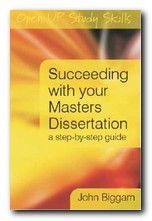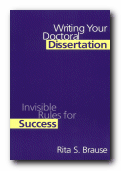tutorial – guidance notes – example – tips
A thesis abstract – definition
A thesis abstract is a digest or a shorter version of the whole thesis. The abstract draws out in summary what’s in the complete thesis. It might also be known as a précis or a synopsis. The term abstract derives from the Latin ab— (away from) and tract— (to draw).
Purpose of an abstract
The original purpose of an abstract is to give an overview of the whole work. This enables a reader to determine the relevance of the thesis for their own purposes.
For instance, a librarian might read the abstract in order to know how to catalogue the thesis. Specialist researchers would read the abstract to see if the work as a whole covered the same topic on which they were working.
The function of the abstract is to prepare the reader for the full document. This is why the substance of the abstract must reflect the essence of the research in terms of —
- topic
- focus of the hypothesis
- methodology
- results
- rationale
For a supervisor, it sets the work in a useful context of overview. For a fellow student it facilitates research by indicating the content in summary and therefore making selection of resources more efficient.
Form
The abstract is a detachable, unbound section of the thesis normally comprising a single A4 page.
Length
The abstract should be very concise – maybe as little as a single paragraph of (say) 500 words. That’s why an abstract is quite difficult to write. You need to compress the whole of the thesis into an abbreviated series of statements, omitting illustrative details. There is no room for any padding. It requires good summarizing skills.
Example
Here’s an example of an abstract from a study of fire in plant-mammal interactions. Below it is an edited version showing that the abstract follows the criteria enumerated above.
The Latitudinal Defense Hypothesis predicts that levels of defense are highest near the equator and decrease toward the poles. This hypothesis is based mainly on insect herbivory that occurs during the summer. Mammilian herbivory in the winter is a more likely driver of plant defense levels in northern latitudes. Early successional trees such as birches are favored by fire and provide an important food source for mammals like snowshoe hares. In order to test the Latitudinal Defense Hypothesis, we collected birch seeds from eight locations in northwestern Canada and grew seedlings in a common garden. We assessed levels of defense by counting resin glands because resin glands are negatively correlated with snowshoe hare preference. This research will provide valuable information regarding the biogeography of defense and address the role of fire in plant-mammal interactions on a continental scale.
Analysis of an example abstract
1. Initial statement of the overall topic.
The Latitudinal Defense Hypothesis predicts that levels of defense are highest near the equator and decrease toward the poles. This hypothesis is based mainly on insect herbivory that occurs during the summer.
2. Brief statement of the specific focus of the hypothesis.
Mammilian herbivory in the winter is a more likely driver of plant defense levels in northern latitudes. Early successional trees such as birches are favored by fire and provide an important food source for mammals like snowshoe hares.
3. Explanation of the methodology
In order to test the Latitudinal Defense Hypothesis, we collected birch seeds from eight locations in northwestern Canada and grew seedlings in a common garden. We assessed levels of defense by counting resin glands because resin glands are negatively correlated with snowshoe hare preference.
4. Indication of the results
We found that the number of resin glands from the seedlings raised in a common garden was less than those collected in the eight locations chosen for our study….
4. Rationale of research
This research will provide valuable information regarding the biogeography of defense and address the role of fire in plant-mammal interactions on a continental scale.
Structure of the abstract
The chronological structure of the abstract is not as important as the crucial need to include the four topics exemplified in the example given above.
In some cases, ‘Rationale’ might precede ‘Results’. But it does make obvious sense to begin with the ‘Initial statement of the topic’.
How to write the abstract
Your abstract should be written after you’ve finished your thesis. The difficult part is to summarise in one page a substantial research project which might have taken up to two years to complete.
Preparation
- Tell one of your enlightened peers what your thesis is about
- Ask if they’ve understood your account
- If they have understood, write down what you said as quickly as possible in rough draft
- If they haven’t understood, tell them again in a different way
- Write down that version in rough draft form
Writing process
- Write the title of your thesis then add the word ‘abstract’
- Type the numbered headings shown above.
- Use your notes to fill in the content in each case.
- Read the abstract through.
- Remove the headings but keep the separate paragraphs
- Tidy up the expression so that the prose is fluent
Notes
Make sure that you –
- Write your abstract in the same style and tone as the thesis
- Remember it’s just a taster to the main event – but like a menu it has to show what’s there
- Include all four elements shown in the sample
- Don’t boast about your research or your achievements in the abstract. Let the work speak for itself.
- Don’t be tempted to rush the abstract, thinking it’s less important than the thesis. It’s all part of the same project
- Don’t use personal references or colloquial expressions. This is a professional document.
- Don’t include sentimental acknowledgements in the abstract.
Details
The abstract is normally written in the past tense. That’s because it is written when the research has been completed and the thesis has already been written. The abstract should also be written last.
Do not use headings in an abstract. For instance – Introduction, Objectives, Methods, Results, and Conclusions. Your explanation of the thesis should be written in continuous prose.
The abstract should be written using the third person passive mode. ‘Samples of the oxides were analysed by …’. It’s possible that the thesis itself is written using the first person – ‘I (or we) collected samples using …’ – but the abstract needs to be more impersonal and objective.
Don’t use abbreviations, contractions, and acronyms in the abstract. If this is unavoidable, you should write out the term in full the first time it is used, followed by the abbreviation in brackets. For example – “Magnetic Photo-Scanning (MPS) was used to …”
© Roy Johnson 2012
More on How-To
More on literary studies
More on writing skills

